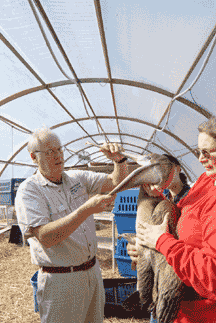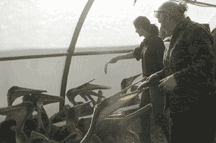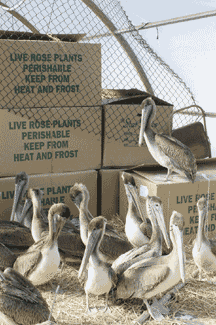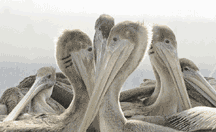|
||||||
Operation Pelican Rescue
|
 |
More than 20 brown pelicans, above, recover in a greenhouse after they were rescued from freezing shorelines along the Bay.
|
Wexler began the large birds’ rehabilitation at Lusby. But they needed more heated space than he could provide. Hearing of the birds’ plight, Gary and Janice Hutt, owners of Red Oak Nursery in Montross, volunteered a greenhouse. February’s killing cold had kept the nursery from potting up the usual number of plants, so there was greenhouse space to spare.
The pelicans traveled by truck from Lusby to the Northern Neck nursery, where they joined the two birds rescued by O’Connor.
Self-professed “animal lovers,” the Hutts gave the pelicans a warm welcome.
“I told Gary to be on the lookout for fox that could crawl up under the greenhouses,” Wexler says. “When I came back the next day, he had put an electric fence around the greenhouses to keep hungry foxes out.”
The Hutts’ enthusiasm was contagious.
“Our employees all want to help,” says Janice Hutt, “so each one of them takes a turn at feeding during the day.”
Pelicans can eat four to five pounds of fish per day. A local bait supplier, Pride of Virginia, has donated over 800 pounds of fish. But that won’t last for long, and one of Wexler’s concerns is finding more fish.
A healthy pelican with a six- to seven-foot wingspan weighs in at around 10 pounds. The rescued pelicans weighed only four or five pounds. But with continuous greenhouse care, the birds have already gained three to five pounds.
Seeking a Ride
Soon, with a little help, the flock will be making the trip south, a bit late and on a different sort of wing.
Their next lodging will be at the Pelican Harbor Seabird Station in Miami, Florida.
Non-profit Pelican Harbor usually concentrates on the rescue and rehabilitation of sea birds out of the Miami-Biscayne harbor. But for these birds, executive director Wendy Fox made an exception, agreeing to accept, rehabilitate and eventually release them back into the wild.
Accommodations have been secured, but transportation from Virginia to Florida is still uncertain.
 |
Wildlife rescue and rehab volunteer Lisa Fischer, left, and Janice Hutt, owner of Red Oak Nursery, feed the hungry pelicans, which can eat as much as five pounds of raw fish a day. |
C130 planes with heated cargo areas would be just the ticket. “We’re working with the Air National Guard,” Wexler says, “but we’re not sure they’ll be able to help despite their willingness to try.”
If the Guard can’t provide transportation, wildlife rehabilitation specialist Mary Martin is ready to step in. “I work for the C.O. at Patuxent Naval Air Station,” Martin says, “and I won’t hesitate to ask him for help to get these birds down to Florida.”
If all else fails, Wexler will put together a convoy of heated trucks and drive the pelicans safely south.
Until then, the birds need medical attention and continuous care.
Back for More
Back in the greenhouse, Wexler, O’Connor, licensed wildlife rehabilitation volunteers Lisa Fischer and Mary Martin, the Hutts and a pair of willing onlookers conducted a daylong pelican triage. Each of the 24 birds was examined and weighed, their condition carefully recorded. All of the birds suffer from dehydration, malnutrition and some degree of frostbite, mainly on their feet and chests. More than half were diagnosed with some level of respiratory distress.
 |
The cold spell that caught the pelicans out of their element also kept Red Oak Nursery from planting this spring’s roses, which remain boxed. |
Each bird was marked with a dot of colored spray-paint on the back of the head to identify it by weight, and a black marker to indicate relative health: One stripe means okay, with up to four stripes indicating poor condition. These identifying marks and meticulous written notes will enable caregivers at the Miami facility to continue treatment. Wexler expects all of the rescued birds to survive.
But winter’s survival story isn’t yet over. With freezing temperatures expected to continue, pelicans still in our cold north have a slim chance of survival.
Back on Maryland shores, rescue efforts continue.
“Two teams of biology students in the field are still finding birds in trouble,” says Wexler. At last count, four more had been rescued; Wexler expects more. On the Virginia side of the river, O’Connor leads a vigilant lookout for any stragglers.
The bi-state rescue efforts “will continue.” Wexler promises, “as long as necessary, until we find all of the surviving birds.”
The Tearmans are first-generation Huntingtown farmers. Margaret is a regular contributor, who last described the long climb of D.C. Acting Police Chief Cathy Lanier; Tom, retired from the Smithsonian Institution, here shoots his first story for Bay Weekly.



